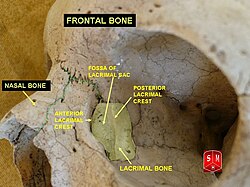Lacrimal bone
| Lacrimal bone | |
|---|---|
 Position of the lacrimal bone (shown in green). | |
 Medial wall of the orbit. Lacrimal bone is in yellow. | |
| Details | |
| Identifiers | |
| Latin | os lacrimale |
| TA98 | A02.1.09.001 |
| TA2 | 744 |
| FMA | 52741 |
| Anatomical terms of bone | |
The lacrimal bones are two small and fragile
Structure
Lateral or orbital surface
The lateral or orbital surface is divided by a vertical ridge, the posterior lacrimal crest, into two parts.
In front of this crest is a longitudinal groove, the
The portion behind the crest is smooth, and forms part of the medial wall of the orbit.
The crest, with a part of the orbital surface immediately behind it, gives origin to the lacrimal part of the
Medial or nasal surface
The medial or nasal surface presents a longitudinal furrow, corresponding to the crest on the lateral surface.
The area in front of this furrow forms part of the
Borders
Of the four borders:
- the anterior articulates with the frontal process of the maxilla;
- the posterior with the lamina papyraceaof the ethmoid;
- the superior with the frontal bone.
- The inferior is divided by the lower edge of the posterior lacrimal crest into two parts:
- the posterior part articulates with the orbital plate of the maxilla;
- the anterior is prolonged downward as the descending process, which articulates with the lacrimal process of the inferior nasal concha, and assists in forming the canal for the nasolacrimal duct.
Development
The lacrimal is ossified from a single center, which appears about the twelfth week in the membrane covering the cartilaginous nasal capsule.
Articulations
The lacrimal articulates with four bones: two of the neurocranium, the frontal and ethmoid, and two of the viscerocranium, the maxilla and the inferior nasal concha.
Other animals

In early
Dinosaurs
In dinosaurs, the lacrimal bone usually defines the anterior rim of the orbit (eye socket), and the posterior rim of the
Additional images
-
Position of the lacrimal bones (shown in green). Animation.
-
Animation. Some bones are removed to show the position of the lacrimal bones (shown in green).
-
Orbital bones. Lacrimal bone shown in green.
-
A left lacrimal bone. Enlarged. Animation.
-
Lacrimal bone
-
Lacrimal bone
See also
References
- PMID 24743297.
- ISBN 978-0-07-340371-7.[page needed]
- ISBN 0-03-910284-X.
- S2CID 85354215.
External links
- Atlas image: eye_5 at the University of Michigan Health System
- Atlas image: rsa2p4 at the University of Michigan Health System
- "Anatomy diagram: 34256.000-1". Roche Lexicon - illustrated navigator. Elsevier. Archived from the original on 2012-12-27.
- Diagram at upstate.edu






